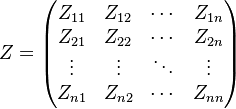Input-Output Matrix
Contents
Definition
The Industry Transaction Matrix (or Transactions Table) is the fundamental quantitative information used in Input-Output Analysis. It concerns the flow of products from each industrial sector (considered as a producer) to each of the sectors, itself and others (considered as consumers).[1]
Formula
Single Region Case
Usually denoted as Z, if there are n sectors in an economy the matrix reads:
- The entries of the matrix may denote either monetary values (in some defined currency) or physical (activity) values, e.g. volumes.
- The matrix is a flow matrix, hence values refer to a particular time period.
Multi-Regional Case
In the case of a Multiregional Input-Output Model where industrial sectors operate within distinct "regions" (e.g., countries) the transactions matrix is most convinently expressed as a Tensor  that captures exchanges between sector i and j located in regions p and q respectively. In practice this tensor is represented as a "rolled-out", Partitioned Matrix.
that captures exchanges between sector i and j located in regions p and q respectively. In practice this tensor is represented as a "rolled-out", Partitioned Matrix.
Usage
This basic information from which an input-output model is developed is contained in an interindustry transactions table. The rows of such a table describe the distribution of a producer’s output throughout the economy. The columns describe the composition of inputs required by a particular industry to produce its output.
The Transaction Matrix is of fundamental importance and may underpin alternative possible input-output models.
See Also
Code
References
- ↑ R.E. Miller and P.D. Blair, Input-Output Analysis: Foundations and Extensions, Second Edition, Cambridge University Press, 2009
